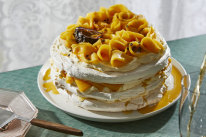Simply the zest: When life gives you lemons, make Emelia Jackson’s zingy drizzle cake
Because the simple, classic (and citrus-drenched) cakes are very often the best.
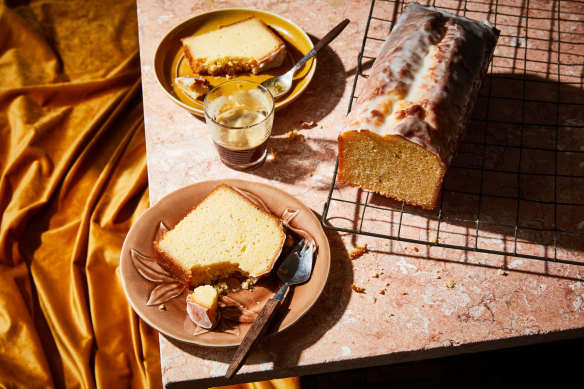
Some of the most beautiful bakes are the simple ones: buttery Scottish shortbread, a perfectly flaky scone with jam and cream, and this lemon syrup cake. The syrup adds moisture, yes, but also enhances that zingy lemon tartness. And the best part? It extends the shelf life so your cake will stick around for a few days (if it lasts that long).
Technique of the month: zesty sugar
To really enhance the flavour of citrus zest in your bakes, I recommend rubbing the zest into the sugar before you start baking. This process will help release the oils in the zest while also helping to distribute the zest evenly throughout the batter (rather than having it stick to your beater while mixing).
Ingredients
zest of 1 lemon
215g caster sugar
5 eggs, at room temperature
250g unsalted butter, melted and cooled
juice of 1 lemon
325g cake flour
2½ tsp baking powder
pinch of salt
Lemon syrup
175g water
100g caster sugar
juice and zest of 2 lemons
¼ tsp citric acid powder (optional, see tip)
Lemon glaze
100g icing sugar
juice of 1 lemon
pinch of citric acid (see tip)
Method
Step 1
Preheat the oven to 160C fan-forced (180C conventional) and prepare a 26cm loaf tin by brushing with melted butter (or spraying with cooking oil) and dusting with flour. Alternatively, line the tin with baking paper. Set aside.
Step 2
To begin, combine the lemon zest and caster sugar in a bowl and rub together with your fingertips to release the citrus oils.
Step 3
To make the cake, combine the eggs, melted butter and juice in a medium bowl and whisk to combine. In a large bowl, whisk together the flour, lemon sugar, baking powder and salt. Make a well in the centre of the dry ingredients and add the wet ingredients. Fold together gently, being careful to not overwork the gluten in the batter.
Step 4
Pour the batter into the prepared loaf tin and bake for between 1 hour and 1 hour 10 minutes, or until a skewer inserted in the centre comes out clean. Allow the cake to cool in the tin.
Step 5
To make the syrup, place the ingredients in a saucepan and bring to the boil to dissolve the sugar.
Step 6
When the cake has cooled, pierce it all over with a fine skewer and pour on the hot syrup so it soaks into the cake. Allow the cake to cool completely for a couple of hours before glazing. You can do up to this point the day before serving, and place the soaked cake in the fridge overnight.
Step 7
To make the glaze, mix the ingredients together in a small bowl and brush over the cake with a pastry brush. Allow the glaze to set before serving so you get that crystallised crunch.
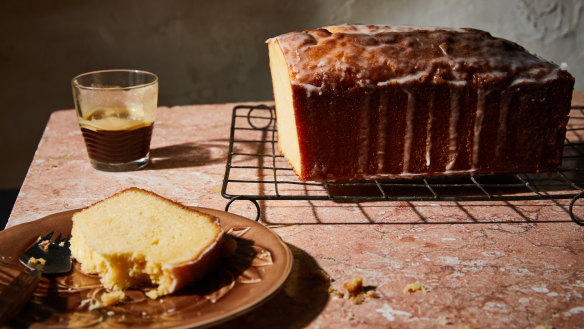
Tips
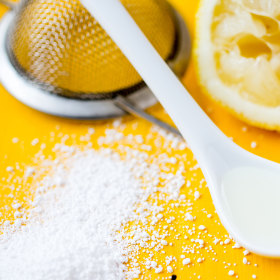
- I’ve added citric acid to the syrup and glaze on this cake to really up the ante on the sour notes. Available in most supermarkets, citric acid is a great ingredient to become familiar with, especially when making sorbets and citrusy desserts. It’s a taste-as-you-go ingredient – I haven’t provided a specific amount because you need to adjust it to your taste.
- Piercing the cake with a skewer when it comes out of the oven will ensure the syrup evenly soaks the entire cake, leaving no dry patches. I like to let this cake sit in the fridge overnight to let the syrup work its magic.
Appears in these collections
The best recipes from Australia's leading chefs straight to your inbox.
Sign upFrom our partners
Similar Recipes
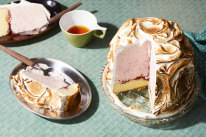
Looking for the ultimate party pud? Emelia Jackson’s retro ice-cream cake is the bombe
- 30 mins - 1 hr
- Emelia Jackson

